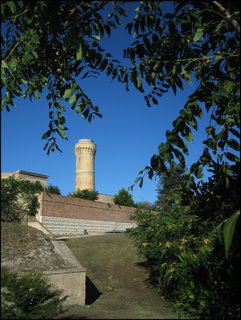ANCONA (part III): More than just a transportation hub
 IF YOU'VE TRAVELED THROUGH Italy, you most likely associate the city of Ancona with transportation.
IF YOU'VE TRAVELED THROUGH Italy, you most likely associate the city of Ancona with transportation. As travelers, me and my friends have probably spent the most amount of time in Ancona anxiously waiting to leave: our four hour train to Rome, our overnight ferry to Croatia and our multiple bus trips home to our apartment in Camerano.
However, it isn’t until a day trip devoted to the city itself, that we realize the historic sites, architecture, views, cafes and shops are worth at least a day of exploring.
Driving into the city, we are naturally drawn to a large dome at the top of a hill overlooking the Adriatic Sea. Following sporadically placed arrows, we wander up the Colle Guasco hill, tripping over random cobblestone streets, lingering under stone bridges and climbing steep steps to reach the peak.
At the top, I can see that the 300-foot dome is part of the Cathedral of San Ciriaco. Drenched with sweat and panting, we walk past two stone lions through the Cathedral’s Gothic style door, only to be kicked out by an old Italian man who scoldingly points to our tank tops. If we had been covered, we could have seen the crypts inside that contain the remains of a temple from the third century B.C.
Dehydrated from our hike up, we walk down the street a little ways to a small café appropriately named Bar Duomo. Terrace seating with a nice breeze and beautiful views of the Adriatic Sea makes it an ideal spot to rejuvenate with a gelato or cold drink.
“What should we see in Ancona?” I ask our waiter.
He leads me to the café’s side balcony and points to Ancona’s main landmarks in broken English. Looking out at the city, I can’t distinguish any lasting destruction from WWII bombings or damage from a large earthquake in 1972.
From my many bus trips I recognize the Arch of Trajan, a 61-foot high marble arch bordering the Adriatic. Further from the sea, at the base of the Colle Guasco hill the waiter points to an amphitheater and a lighthouse on an adjacent hill in the Parco del Cardeto.
Both sound interesting and look within reasonable walking distance. After a drink, we decide to descend Colle Guasco to get a better look at the amphitheater.
The “amphitheater” is a disappointment. Surrounded by a metal fence and overgrown with weeds, the crumbling form of what was once an impressive public venue in the first century AD, now looks more like a zoo exhibition.
 Ready to redeem ourselves, we head towards the lighthouse at the top of another hill. At street level it is difficult to get our bearing so we ask a couple of Italians in the street where to go. Doubting our vague directions, we walk past residential house’s driveways to a dirt path. Despite some intimidating signs signaling that we are on Military Property, we continue to a modern lighthouse, built in 1970. Beyond the modern lighthouse is an original 1860 lighthouse donated to the people of Ancona by Pope Pius IX.
Ready to redeem ourselves, we head towards the lighthouse at the top of another hill. At street level it is difficult to get our bearing so we ask a couple of Italians in the street where to go. Doubting our vague directions, we walk past residential house’s driveways to a dirt path. Despite some intimidating signs signaling that we are on Military Property, we continue to a modern lighthouse, built in 1970. Beyond the modern lighthouse is an original 1860 lighthouse donated to the people of Ancona by Pope Pius IX. It is somewhat disappointing to discover that the lighthouse is not open to the public but the peaceful scenery is worth the trip alone. Free from the crowded streets and noises of buses, trains and ferry whistles, a solitary wooden chair that overlooks the Adriatic Sea provides the perfect seat to detach from city life. A poster on a closed snack shop front informs visitors of summer night concert dates performed on a small stage adjacent to the lighthouse.
Besides the historic sites, Ancona also has some worthwhile modern attractions. There are a couple shops like Zara, United Colors of Benetton and Max & Co that have reasonable prices and a wider selection of cute clothing compared to their American branches.
On Tuesdays and Fridays, Piazza d’Armi has an open market from 8 to 12 and Corso Mazzini has one everyday except Sunday where you can pick up inexpensive clothes, knick-knacks, and souvenirs. After shopping, various piazzas’ around the city, sit at a café and people watch amidst 16th century architecture and statues.
Rather than a destination, people usually think of Ancona as merely a stop off point, the beginning or end of various bus, train, ferry or plane trips.
Instead of sitting in a station you should take a look around.
- Philly Petronis

0 Comments:
Post a Comment
<< Home